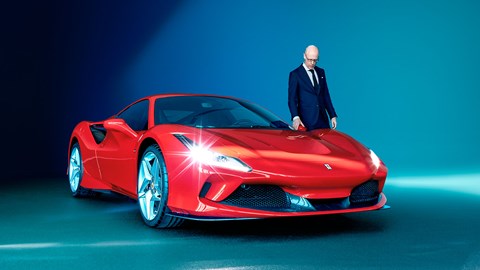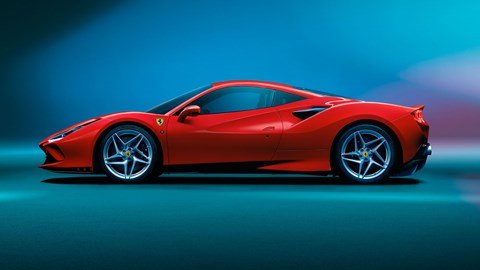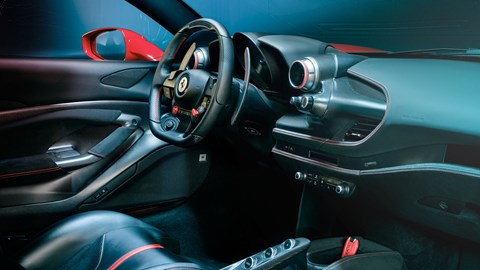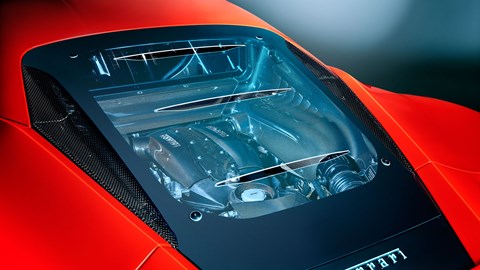► New F8 Tributo
► A tribute to 710bhp turbo V8
► Upgraded aero
Aston’s Vanquish is one of a horde of rivals storming Ferrari’s patch. Its response? Everything that made Pista special in a faster, smarter 488 – the new F8 Tributo.
For Ferrari, the enemy isn’t so much at the gates as crashing through them with sheer weight of numbers: fortress Maranello is under siege. From McLaren, an endless stream of exceptional sports cars, with two of the best – the outrageously talented 720S and ferocious 600LT – aimed squarely at Maranello’s mid-engined V8, until now the 488 GTB.
From Lamborghini, an uprated Huracan with something of the Ferrari’s wondrous balance – and a naturally-aspirated V10. And then there’s Aston Martin’s new Vanquish, an unapologetically aggressive move before you consider that it’s being engineered by a couple of brilliant ex-Ferrari minds…

What’s more, Ferrari has quite a bit on. Mercedes will once again require keeping honest in Formula 1, and on the road-car side Ferrari’s new CEO, Louis Camilleri, is furiously cranking the new product handle like a man possessed. Chief technical officer Michael Leiters has everything from a new supercar through a V6 hybrid powertrain to the Purosangue SUV on his (presumably enormous) drawing board.
‘Ferrari is having a very important year – we are doing so many projects,’ confirms Leiters with a wry smile. ‘We have never done so many, and with so many innovations on those projects. It’s very exciting. And for Ferrari it was important to do a big step with this car.’
That car is the new F8 Tributo.
Restablishing dominance
It replaces the 488 GTB as Ferrari’s frontline mid-engined sports car, and has been created with the sole purpose of re-establishing Ferrari’s dominance in a space it created. For many the mid-engined V8 is Ferrari; exotic, race-bred, intoxicating. It must remain the definitive modern two-seat sports car. To ensure that it does, Leiters and his team have turned to their secret weapon, the 488 Pista, and drawn from it all the technical innovations and extreme performance thinking that make that car special.
‘The F8 is a significant step forward,’ says Leiters. ‘The heart of the new car is the new 710bhp engine, the same as the 488 Pista’s; the lighter engine internals, the titanium conrods – everything. This is definitely the most important part of the Tributo.’

He’s not kidding. Let’s ponder for a moment the wonder of a series-production sports car with a race car’s heart and conrods in a metal so light and expensive it normally rules itself out the second anyone pulls out a calculator. On a special edition, yes, but on a series-production V8? Too expensive, surely?
‘This is definitely cost-intensive technology but for this car we wanted the best engine of the last 20 years [an award bestowed upon the Pista’s twin-turbo V8 by the International Engine of the Year jury],’ says Leiters. ‘That’s why we decided to put the economic effort into this engine.’
Increased performance
Together with the 50bhp power increase, the Pista-derived V8 brings with it an 18kg weight saving (the F8’s overall weight is down 40kg versus the 488, to 1330kg dry): inconel exhaust manifolds cut 9.7kg, the conrods 1.7kg and the lightened flywheel and crankshaft 2.7kg. Peak torque is 568lb ft at 3250rpm and, as befits such a race-bred engine, blunder into the rev limiter and you’ll simply hit it, rather than suffer a gradual loss of power on the way to it, as you do in the 488 GTB. The power increase puts the car on a par with McLaren’s 720S, and clear of the Huracan Evo.
The new V8’s 0.1sec quicker 0-62mph than the 488 GTB at 2.9sec (2.85sec for the Pista) and 0.5sec quicker 0-124mph at 7.8sec (7.6sec for the Pista).

But numbers don’t do justice to an engine so potent and charismatic that it propelled the Pista to first place in CAR’s 2018 Sports Car Giant Test, ahead of the monstrously talented Porsche 911 GT2 RS. Pista owners had to fight their way into an elite queue and stump up £253k before options. In the new F8 Tributo, it’ll be a good deal less expensive.
To ensure you never forget the very special engine’s right there at your back, a duct will channel its aural splendour into the cockpit. Leiters: ‘We have a new exhaust system which negates the impact of new emissions tests, and includes a new particulate filter. We also have a membrane just after the turbo compressors and a duct to bring the sound directly to the cabin – it is even more emotional and involving than it is on the 488 GTB.
The end of the V8 story?
It is for its music that most of us prize Ferrari’s V8, and worry for its surely inevitable demise. It’s thought McLaren’s V8 will give way to a hybrid-assisted V6 in the near future, the same solution Aston’s developing for its sub-Valkyrie mid-engined supercars. But don’t worry – Ferrari’s V8 is not going anywhere just yet. Trust in Leiters.

‘This is not the end of our V8 line,’ he says. ‘The turbo V8 will remain an important pillar of our engine range. We are working on a V6 but it won’t replace the V8. Downsizing will be important, and the V6 – combined with hybrid technology at different levels, not always full hybrid – will be important too. But this will not replace the V8. Technically the V8 is difficult to keep alive but we are working on this, and in the mid-term we can maintain three families: V12 naturally-aspirated, V8 turbo and V6 turbo.’
The rest of the F8 is broadly familiar from the 488 GTB and Pista, featuring an aluminium-intensive monocoque with double-wishbone front and multi-link rear suspension. But Ferrari’s engineers have worked through each of its key systems making small but significant changes, from suspension set-up through the steering wheel itself to the stability control system.
Electronics
‘The suspension set-up is more sophisticated and we have a new steering wheel [smaller in diameter and thinner of rim] for a compact feeling and a high degree of control,’ says Leiters. ‘We also have a new control system on the car, to help make it easier to drive on the limit. There are many minor improvements that add up to improve the handling.’
That control system is version 6.1 of Ferrari’s Side Slip Control (SSC), which also bundles in the Dynamic Enhancer miracle-worker previously reserved for the Pista. Essentially a highly intelligent, almost predictive accessory to Side Slip Control, Dynamic Enhancer (available in the Race and CT Off positions on the manettino) builds on SSC’s manipulation of the car’s limited-slip differential to bring in a little driver-flattering brake tweaking.

The system uses SSC’s algorithms to detect an imminent slide. If it decides the slide wasn’t deliberately provoked then it works the brakes to counteract a sudden loss of traction and negate the need for hurried armfuls of opposite lock. But if it thinks you know what you’re doing it’ll merely lend a helping hand, imperceptibly scrubbing the front and rear brakes to let you indulge in spectacular yet safe oversteer.
Leiters: ‘It helps a lot when you go to the limit – and especially when you go over the limit. The system places a high demand on the brakes and on the differential so we wanted to have it only in certain circumstances. We need it only for the driver when they are driving to the limit in a very sporty way – so it’s available in Race and CT Off modes.’
The very best bits of the Pista, then, wrapped in a body that blends a little of that car’s track-bred menace with some heart-melting retro flourishes. Same wind-cheating thinking (for a 10 per cent increase in aero efficiency), same impossibly waisted silhouette, new rear lights – gone are the GTB’s single round lamps, replaced by two pairs that evoke older Ferrari V8s like the 308. Cutting-edge technical solutions melded with a little of the romance of the past – what better way to see off those impudent rivals?
Check out our Ferrari reviews